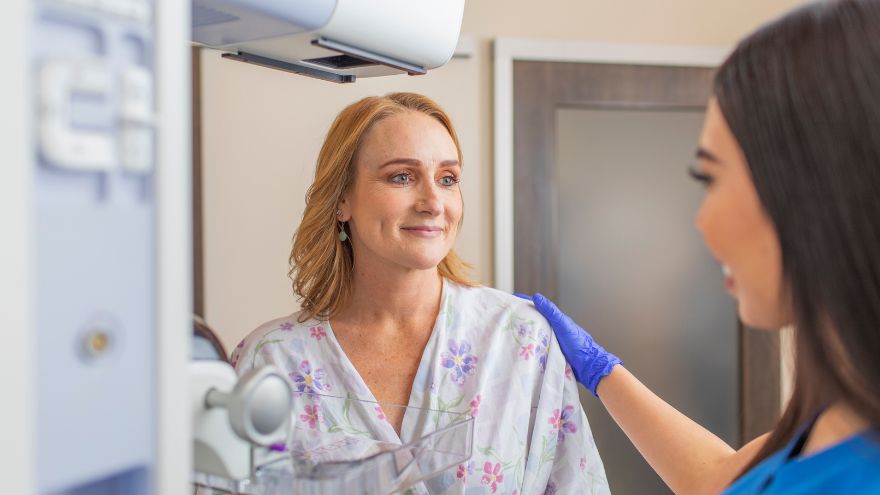Search
-
Which Type of Breast Health Screening is Right for You?
Reviewed by Dr. Colleen O'Kelly-Priddy, MD, FACS, breast surgical oncologist at Renown Women's Health. In the United States, breast cancer is the most common cancer among women, with approximately 1 in 8 women developing breast cancer during their lives, reports the American Cancer Society. These statistics can be a little startling; however, when it comes to taking charge of your health, early detection is key. The National Breast Cancer Foundation, Inc. reports that when breast cancer is caught in its earliest, localized stages, the 5-year relative survival rate is 99%. The earlier breast cancer is found, the more treatment options are available and better survival rates are seen. New technology and evolving screening guidelines are crucial for women to understand and choose the right screening method for their specific needs. The most common types of screenings available today are: 2-D Mammography 3-D Mammography Whole Breast Ultrasound What is the Difference Between 2-D Mammography and 3-D Mammography? 2-D Mammography: In a standard 2-D mammogram, the tech takes X-rays of the breast, compressing it top-to-bottom and side-to-side, providing a 2-dimensional view in each direction. These pictures can show the radiologist if there are abnormalities you might not be able to feel. 3-D Mammography: In 3-D mammography, or “tomosynthesis,” the process is largely the same, but more images are taken, and it takes a few seconds longer. This kind of exam provides a more detailed view because it reduces the overlap of tissues that can take place in a standard 2-D mammogram. Using 3-D mammography, radiologists can detect 41 percent more cancers and reduce the number of callbacks for additional imaging. This improvement in technology is great for both patients and their care providers. Renown uses 3-D mammography because it produces better images of the breast, enabling doctors to more accurately diagnose and reduce false positives, especially in women with dense breast tissue.
Read More About Which Type of Breast Health Screening is Right for You?
-
Life-Saving Mammograms: Real Women, Real Stories
Renown patients share how early mammogram screenings transformed their lives. From detecting cancer in its earliest stages to celebrating successful recoveries, these stories emphasize the importance of regular screenings and taking charge of breast health. Early detection is key! Book your mammogram with Renown Women's Health and prioritize your breast health. Book Your Mammogram Angie T. "I'm so grateful that the cancer was caught early. Those screening exams are so important and actually saved my life. I encourage women to make time to get their mammograms like their lives depend on it; because in some cases, it does." Amber S. “I was diagnosed with breast cancer at the age of 40 with what would have been my first annual screening exam. This was caught in the earliest stage possible with many of my findings being only pre-cancerous. Because of early detection, I did not have to have chemotherapy or radiation as part of my treatment plan.” Monica T. “I truly believe the yearly 20-minute diagnostic mammogram screening and findings saved me from allowing cancer to take control of my future.” Jes H. “It is because of breast cancer risk assessment testing that I was able to identify my risk for breast cancer early. I am so very thankful that I am going to be able to watch my children grow up.” Melissa P. “A yearly mammogram can save your life! A routine mammogram found my cancer at stage 1 when it was easily treated! “ Sharon C. “Despite having minimal family history, I was diagnosed at 47. Renown provided exceptional care for both my double mastectomy and reconstruction. For me, knowing my body was the key, when I felt like something was not right, I followed up with my physician and made sure I was doing everything to minimize my risk.” Jamie V. “My annual mammograms have detected 3 lumps in the last 10 years. Two were benign and one was cancer. My annual mammogram and then my ultrasound saved my life by detecting my cancer in its earlier stages.”
Read More About Life-Saving Mammograms: Real Women, Real Stories
-
Guide for Self Breast Awareness
What is a Breast Self-Exam? A breast self-examination is a technique used to check for early signs of potential breast health complications. This physical and visual examination typically only takes a few minutes. Performing monthly self-exams helps you become more familiar with the normal appearance and texture of your breasts, making it easier to recognize any changes during future exams. While monthly self-exams are helpful, it’s important to get an annual mammogram even if you don’t notice anything. Mammograms help provide a 3D scan of the breast tissues, detecting changes that may not be felt during a self-exam. Dr. Cristin Newkirk-Thompson, an MD with Renown Health, discusses the protocols and importance of self-breast awareness. How to Perform a Self-Breast Exam Use the pads of your fingers and move them in a circular motion. Cover the entire breast area from top to bottom, side to side—from your collarbone to the top of your abdomen, and from your armpit to your cleavage. Follow a pattern: circular, wedge, or vertical line, ensuring you cover all tissue. Use varying pressure: light pressure for tissue just beneath the skin, medium pressure for the middle of the breasts, and firm pressure for deep tissue. There are multiple ways to perform a self-breast exam including: Visual Inspection: Stand in front of a mirror with your shoulders straight and your hands on your hips or to your side. This is when you look for any abnormalities or changes. Lying Down: Lying down spreads the breast tissue evenly over the chest wall, making it easier to feel all areas. In the Shower: Many women find it easiest to feel their breasts when their skin is wet and slippery, so you might want to perform this step in the shower. What to Look For Changes in density, size, shape, or symmetry. Dimpling, puckering, or bulging of the skin. Nipple changes such as inversion or discharge. Redness, soreness, rash, or swelling. When to Perform a Self-Breast Exam It’s recommended to perform self-breast exams monthly, a few days after the end of your period. For women in menopause or those who have irregular periods, the specific day isn’t as important, if it is consistent. What to do if You Find a Lump If you notice any new changes with your breasts, don’t panic; there can be several reasons why breasts have changed. It’s best to follow up with your provider to be as proactive as possible. Additional recommended screenings for further examination can be scheduled to have a clearer answer.
-
Why Mammograms Are Vital for Early Breast Cancer Detection | Renown Health
Breast cancer affects 1 in 8 women in the U.S. each year, making early detection crucial in improving the chances of successful treatment. Early Detection for Treatment and Peace of Mind Mammograms are noninvasive X-rays used to detect cancer and other abnormalities in the breast. They are the most effective screening tool for detecting breast cancer early, allowing for timely treatment before the disease can spread and helping to improve treatment outcomes. To help guide you through the mammogram process, we spoke with Elizabeth Kang, PA-C, at Renown Breast Surgery Care to equip you with expert knowledge on what to expect and why screening is so important. How Accurate are Mammograms? 3-D mammography technology at Renown Breast Health Center can detect 41% more cancers and reduce the number of false-positive results compared to plain film mammography. Benefits of 3-D mammography include: Providing better, clearer images, with higher diagnostic accuracy Allowing radiologists to see more abnormalities in the breast Helping doctors spot more cancers and avoid false positives, especially if you have dense breast tissue Reduced callback rates for findings on screening Mammogram Screening and Breast Exam Recommendations Renown Women's Health recommends the following breast exam guidelines: Age 18-39: Consult your primary care provider for a Risk Assessment and start breast exams at age 25. Age 40+: Get your annual mammograms. Family history: Begin screening 10 years before your youngest family member's age at diagnosis. For example, start at age 35 if a family member was diagnosed at 45. Self-awareness: Be familiar with the look and feel of your breasts and report any changes to your care provider. Age 75+: Continue annual mammograms if life expectancy exceeds five to seven years. What screenings are available for women with breast implants? Women with breast implants can and should still receive mammograms, and it’s essential to have these screenings done by an experienced team. Be sure to inform your healthcare provider and mammogram technicians about your implants, as they may recommend special techniques or steps to detect abnormalities and ensure accurate results.
Read More About Why Mammograms Are Vital for Early Breast Cancer Detection | Renown Health
-
What it's Really Like to Have a Mammogram
Have you found yourself avoiding scheduling a mammogram because it sounds uncomfortable and maybe a little scary? Many people feel this way but knowing what to expect can help ease your worries. Follow along for a reassuring step-by-step guide on getting a mammogram from Melissa Dahir, Community Relations Liaison at Renown Health. Getting a mammogram is important to me because my mom is a Stage 3, double mastectomy breast cancer survivor. I began receiving annual breast health screenings at an early age, in addition to performing monthly self-exams. So far, all my appointments have gone well, and I hope that sharing my experience will encourage you to schedule this important screening today! Scheduling the Appointment Scheduling my appointment was very easy. I contacted the scheduling team for help with booking multiple appointments and they were very helpful in finding just the time I needed.
-
Ladies! Get Screened for Breast Cancer
Early detection is a significant piece of the breast cancer puzzle. Susan Cox, Renown Health Senior Director of Cancer Operations, discusses what you need to watch for and how the latest technology can help detect potential cancer sooner. When should women start getting breast exams? It depends on risk factors: Average-risk women: Most medical organizations recommend the first mammogram between 40 and 44. Higher-risk women: Dependent on their high risk, which will dictate when they start screening, but generally around the age of 30 and not before 25 years old.
-
Do Mammograms Hurt? 4 Myths Debunked
Mammograms are an effective means for early detection of breast cancer. Still, many women shy away from them for fear of pain or discomfort. Let us debunk a few mammogram myths that will remove your worries and encourage proactive breast health. Reviewed by Dr. Colleen O'Kelly-Priddy, MD, FACS, breast surgical oncologist at Renown Women's Health. Myth 1: Mammograms Are Painful Reality: Although some women experience discomfort during a mammogram, most say it is not painful. Breast compression, which is important to get a clear image, can cause a sensation of pressure, but this lasts for a few seconds. Let your technician know how much pressure you can handle so you're not uncomfortable. Myth 2: Discomfort Persists Long After the Procedure Reality: The sensation of pressure developed through the compression process diminishes quickly after the procedure. Most women go about their day afterward without experiencing any residual pain.
-
7 Symptoms of Breast Cancer in Young Women
Cancer can develop at any age, and that’s why the experts at Renown are ready to help you stay ahead of breast cancer, especially if you're in your 20s or 30s. We're talking about early detection, signs to be aware of, and why being proactive is a big deal. Studies show there has been an increase in breast cancer in younger women. Although breast cancer is rare in women under 40, when it occurs, it tends to be aggressive. The tricky part? Many young women don't think it can happen to them, so they don't check for the signs as often as they should. Reviewed by Dr. Colleen O'Kelly-Priddy, MD, FACS, breast surgical oncologist at Renown Women's Health. Early Signs and Symptoms New or Different Lump in the Breast: A lump is probably the most well-known symptom. Breast cancer is usually painless and firm, but it can also be soft. If you find a new lump, don't panic, but don't ignore it either. Changes in Breast Size or Shape: Have you noticed that one breast looks a little different? Whether it's swelling, shrinking, bulging, dimpling, or seems off, it's worth mentioning to your doctor. Skin Changes: If the skin on your breast starts to thicken or turn red, it's time to pay attention. If your skin starts looking like an orange peel (thickened, with prominent pores), that warrants evaluation. Nipple Discharge: Spontaneous drainage coming from your nipple that isn't breast milk—especially if it's clear or bloody—should be checked out. Nipple Changes: If your nipple starts to invert, flatten, or look different, call your doctor. Breast Pain: Continuous pain in your breast or nipple that isn't linked to your menstrual cycle is another symptom to note. However, breast pain is very common and is only rarely a sign of cancer, so don’t panic. Swelling or Lumps in the Armpit: When it spreads, breast cancer usually first goes to the lymph nodes in the armpit, so swelling or lumps under your arm should be on your radar.
-
Dr. Carilyn Hoffman's Guide to Menopause Medication & Relief
Women undergo multiple hormonal changes throughout their lives, leading to different physical and emotional experiences. Dr. Carilyn Hoffman, at Renown Women's Health, explains these confusing life stages and helps decode menopause. Perimenopause: Transitioning Towards Menopause Defined as the time "around menopause," perimenopausal symptoms are caused by hormonal fluctuations that occur as the ovarian function declines. Levels of estrogen and progesterone decrease, and follicle stimulating hormone increases. These hormonal fluctuations may cause a range of symptoms including: Irregular or abnormal periods: Initially cycles intervals vary in length by greater than 7 days, then in later stages the interval increases to greater than 60 days between cycles Hot flashes and night sweats: This is the most common symptom and 50-82% of women will have vasomotor symptoms Mood swings and memory problems Anxiety or insomnia Heart palpitations Decreased libido and vaginal dryness Weight gain and thinning hair Increased risk of urinary tract infections Decreased bone density Menopause Menopause is defined as year without a menstrual cycle and marks the timeframe when the ovaries stop making estrogen. This signifies the end of the reproductive years. The average age of menopause is 51; however, the menopausal transition can last about 8 years. This means that women in their late 30’s and 40’s may start to have symptoms of perimenopause. The worst vasomotor symptoms are typically experienced at the one-year mark since the last period. Unfortunately, some women experience symptoms throughout the entire menopausal transition. Postmenopausal After 12 months without a menstrual cycle, a woman is confirmed to be postmenopausal. This is sometimes difficult to define, as women may have had procedures that cause menstrual suppression such as a uterine ablation or hysterectomy or they may still be on contraception. Sometimes, lab work may be recommended to help determine menopausal status. However, due to the broad time period that the menopausal transition occurs and the variations in normal hormone levels throughout a cycle, lab work is not always helpful. Dr. Hoffman explains the importance of thorough counseling for patients seeking to "check their hormone levels." She emphasizes that menopause is diagnosed clinically, focusing more on the individual's symptoms rather than lab values. This approach ensures that patients understand the implications of the test results and the treatment strategy. Menopause Medical Management Medical management of symptoms should be tailored to the individual’s concerns. Abnormal Bleeding: There are a range of medications, IUDs and procedures available if the main concern is irregular or prolonged menstrual bleeding during perimenopause. Hot Flashes and Night Sweats: Hormone Replacement Therapy (HRT): HRT is currently the most effective method for relieving vasomotor symptoms. However, it's important to discuss potential risks with a healthcare provider, as HRT can increase your risk of blood clots and breast cancer. If improperly prescribed, it can also increase the risk of uterine cancer. The American College of Obstetricians and Gynecologists recommends the lowest dose for the shortest duration. Low-dose antidepressants: SSRIs/SSNIs may mitigate hot flashes and mood disorders for those who are not candidates or prefer to avoid HRT. Currently, only Paroxetine is FDA-approved for this use. Fezolinetant: This is a newly FDA-approved non-hormonal medication that works at the brain's level to treat vasomotor symptoms. Gabapentin: This is an anticonvulsant medication that has been shown in several studies to be helpful for vasomotor symptoms, but it is not currently FDA-approved. Genitourinary Symptoms of Menopause: Vaginal estrogen: Vaginal dryness and pain with intercourse due to thinning vaginal tissue is a common symptom of menopause. Vaginal estrogen is highly effective at decreasing these symptoms and has fewer side effects than systemic HRT. Ospemifene: This is a selective estrogen receptor modulator that is a non-hormonal FDA-approved medication for severe vaginal dryness. Natural Symptom Relief Strategies: Nutrition: Incorporate calcium, vitamin D, and high-quality protein to support bone health and muscle maintenance. There are limited studies on phytoestrogens (found in soy and tofu) and vasomotor symptoms. While the data doesn’t necessarily support that these phytoestrogens relieve symptoms, no detrimental effects were found and these tend to be high quality and healthy proteins. Exercise: Regular physical activity can ease menopausal symptoms and support weight management. Data doesn’t support that this reduces vasomotor symptoms, but it can be helpful in weight management and sleep quality. Beverage choices: Limiting alcohol and caffeine can help decrease the frequency of vasomotor symptoms and may also improve sleep quality. Alternative remedies: One study shows that Chinese herbal medicine and acupuncture are effective at relieving vasomotor symptoms. There is not enough evidence to recommend Black Cohosh, and it is associated with liver toxicity in high doses. Studies don’t show that St. John’s Wart or Gingko Balboa are any better than placebo. Always mention your alternative medical therapies to your provider as some do interact with other prescribed medications. By understanding and recognizing that the symptoms of menopause are real and treatable, women are empowered to manage this transition better and can maintain their well-being and quality of life. Please schedule an appointment with Renown Women’s Health if you’d like to discuss your menopause symptoms with a provider.
Read More About Dr. Carilyn Hoffman's Guide to Menopause Medication & Relief
-
What is an Ovarian Cyst, and How is it Treated?
Abdominal pain is one of the most common reasons for an Emergency Room visit. The abdomen is an area that encompasses multiple organs and functions. So how would you know when the pain you are feeling is an ovarian cyst or something else, and when should you seek medical attention? Dr. Carilyn Hoffman, at Renown Women's Health, explains. Ovarian Function Defined Located on each side of the uterus, the ovaries are part of the female reproductive organs and produce eggs (ova), released during the menstrual cycle, allowing for fertilization and pregnancy. They also produce hormones such as estrogen and progesterone, which play an important role in female traits, bone health, cardiovascular health and pregnancy. Symptoms of an Ovarian Cyst Cysts are solid or fluid-filled masses. Ovarian cysts can be in the ovary or on its surface. When cysts are enlarged or rupture, they can create a dull ache or sharp pain below the belly button. Besides discomfort and pain, other symptoms of ovarian cysts may include bloating, fullness, pressure or heaviness. "Ovarian cysts are common; most are physiologic and will go away on their own. They are frequently found incidentally on ultrasound and are present in the middle of the menstrual cycle," says Dr. Hoffman. "However, if a woman experiences sudden and severe pelvic pain they should seek immediate medical attention. Sometimes ovarian cysts can become large and twist on themselves. This is called ovarian torsion and is a surgical emergency. Other times, cysts can rupture and bleed. This is called a hemorrhagic cyst and can also be a surgical emergency." Diagnosis and Treatment If an ovarian cyst is suspected, your doctor will perform a pelvic exam and order an ultrasound. There are certain ultrasound findings that suggest that the cyst is benign. There are other ultrasound findings that are concerning for cancer. Small simple cysts often resolve on their own, whereas solid or very large cysts may require surgery.
Read More About What is an Ovarian Cyst, and How is it Treated?
-
The Expanded Role of OBGYNs in Women's Healthcare
Obstetrician-gynecologists (OBGYNs) see patients from menses (the monthly menstrual cycle that occurs as a part of the female reproductive system), pregnancy and childbirth through menopause and play a pivotal role in managing reproductive health and overall wellness. Dr. James Alexander with Renown Women's Health explains. "As experts in women's health, we are uniquely positioned to recognize subtle changes or symptoms that might indicate broader health issues. This comprehensive approach allows us to serve as a valuable first touchpoint for various health concerns." Preventive Screenings: A Proactive Approach One key aspect is an OBGYN's ability to recommend preventive screenings based on your symptoms, age, lifestyle and medical history. For instance, lipid screenings are critical for monitoring cholesterol levels, which can be a significant factor in women’s heart disease. An OBGYN keeps up with the current guidelines for routine screening as well as in women with risk factors such as high blood pressure, diabetes, or a family history of heart disease during your visit. By identifying risks and abnormal screening early, they can collaborate with you to implement lifestyle changes or treatments to reduce your risk of heart conditions. Schedule Your Screening Appointment Make an Appointment by Phone: 775-982-5000
Read More About The Expanded Role of OBGYNs in Women's Healthcare
-
Celebrating Resilience: Raquel's Remarkable Journey Through Breast Cancer Treatment
Raquel was 33 when she was diagnosed with breast cancer. It was April 2023, when she found a lump in her breast and was referred to the William N. Pennington Cancer Institute. After comprehensive imaging, she was diagnosed with invasive lobular carcinoma, which is a type of breast cancer that begins in the milk-producing glands of the breast. Between June 2023 and January 2024, she received a total mastectomy, chemotherapy and radiation at Renown Health. “Breast cancer is uncommon in women under 40, but any woman with a mass or lump in her breast should have an exam by a physician and imaging at any age,” said Dr. Lee Schwartzberg. In fact, according to the Centers for Disease Control and Prevention (CDC), only 9% of all new cases of breast cancer in the U.S. are found in women younger than 45. “It was a pretty scary diagnosis, but I’ve been led by great people through the process,” she said. “They were so helpful and there for me throughout the chemo and radiation.” Raquel's journey through breast cancer treatment at the William N. Pennington Cancer Institute was marked by the exceptional care provided by the Renown Health team, including nurses, nurse navigators, therapists, support teams and providers. Among the dedicated professionals, Dr. Michelle Chu and Dr. Lee Schwartzberg played pivotal roles in Raquel's diagnosis and subsequent treatment plan. Their expertise, compassion and commitment to patient care left an indelible impact on Raquel's experience. Their thorough examination and comprehensive approach ensured that Racquel received the best possible care for her invasive lobular carcinoma. In addition to the care provided at Renown, Raquel greatly benefitted from being connected with a mentor by Dr. Chu. This mentor, Kayla, had undergone a similar diagnosis and treatment plan, and at the same age Raquel. They texted and called each other throughout Raquel’s treatment, providing additional support through a challenging time. As of January 2024, Raquel is done with her treatment and continues to see her care team for follow-up appointments. “I’m through the worst and ready to rebuild my life,” Raquel said. To help celebrate this milestone, Nevada Athletics invited Raquel to receive the game ball at a Nevada Men’s Basketball game. She was joined on the basketball court for this special recognition by her husband, Raul; mother, Arlene; and two daughters, Ryleigh and Rhiannon. Racquel's journey is not only a testament to her resilience but also a tribute to the invaluable contributions of Dr. Chu and Dr. Schwartzberg in guiding her towards triumph over breast cancer.
Read More About Celebrating Resilience: Raquel's Remarkable Journey Through Breast Cancer Treatment











